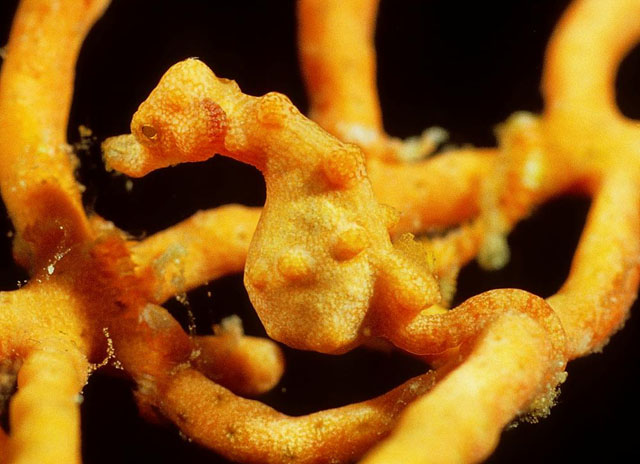| Syngnathidae (Pipefishes and seahorses), subfamily: Syngnathinae |
| 2.15 cm SL (male/unsexed); 2.4 cm SL (female) |
|
reef-associated; marine; depth range 7 - 100 m, non-migratory |
| Indo-West Pacific: Indonesia to Vanuatu; north to the Philippines, south to northeast Australia. |
|
Dorsal soft rays (total): 14-14. Color in life plain orange with slightly darker rings around tail; when preserved, pale orange with tiny dark brown flecks on the nape of the neck and all over in some specimens. Diminutive in size. Anal fin small or absent. Rings on trunk 12; on tail 28-29. Body fleshy with inferior and ventral trunk ridges reduced to separated cross-shaped spicules embedded in the skin. Nuchal plate rounded without a raised coronet. Snout length ca. 30% in HL. Head depth ca. 50% in HL. No spines above the eye. Trunk depth (between the 9th and 10th trunk rings) ca. 7% in SL (female) and 10-15% in SL (male). The angles of certain body ridges sometimes developed into rounded tubercles (distinctly fewer and less developed compared with H. bargibanti) (Ref. 47053). |
| Lives in association with gorgonian seafans (Annella reticulata, Muricella sp., and Echinogorgia sp.). Master of camouflage, with their coloration and body ornamentation in the form of tubercles, can match the stems and polyps of their gorgonian hosts (Ref. 47053). Ovoviviparous (Ref. 205). The male carries the eggs in a brood pouch which is found under the tail (Ref. 205). |
|
Data deficient (DD); Date assessed: 08 October 2015 Ref. (130435)
|
| harmless |
Source and more info: www.fishbase.org. For personal, classroom, and other internal use only. Not for publication.

